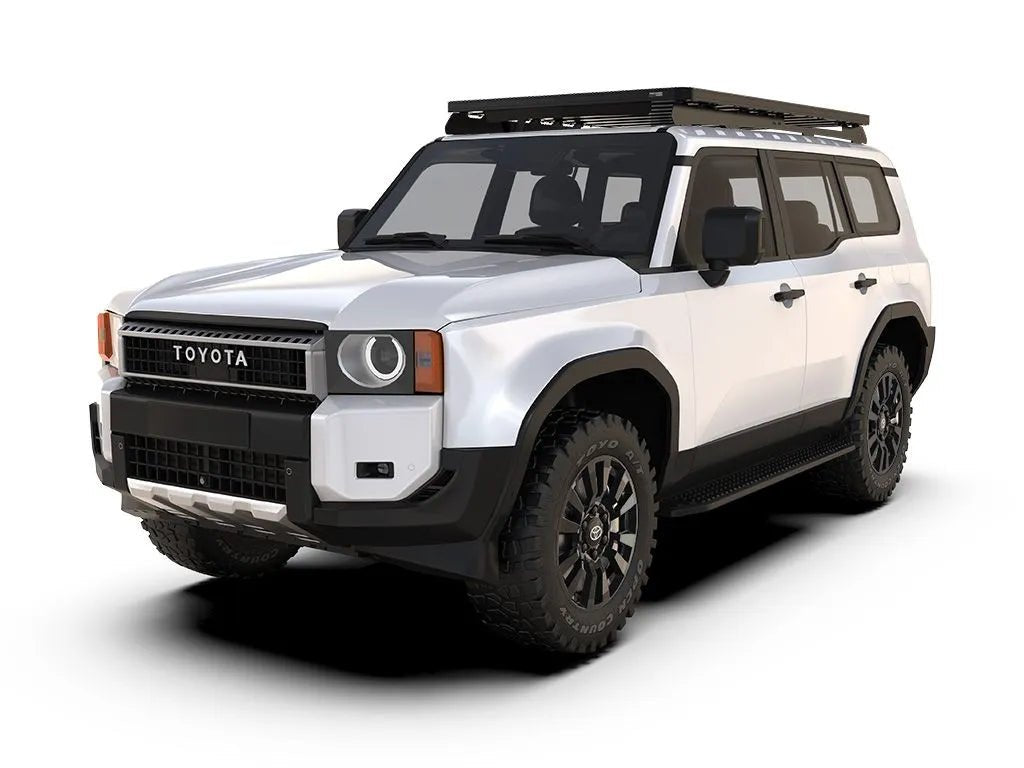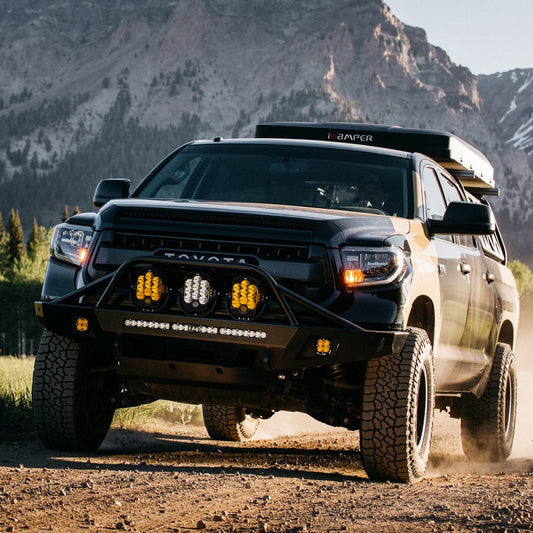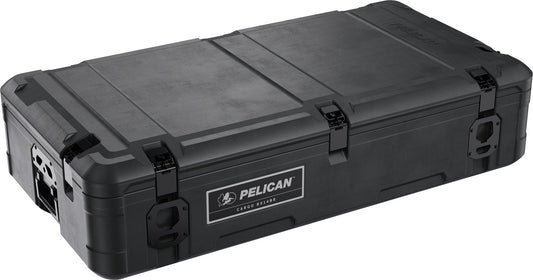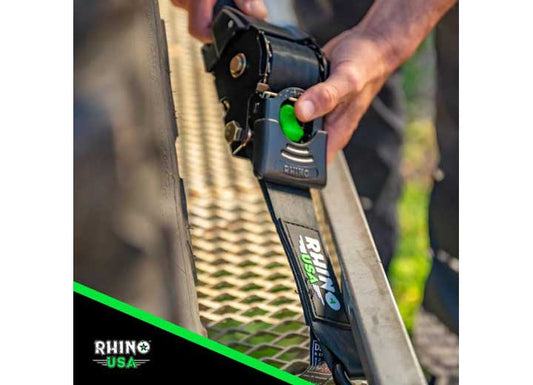Introduction
When it comes to overlanding and adventure travel, having a reliable roof rack is essential. It’s not just about adding extra storage space—it’s about ensuring that your gear is secure and your vehicle is ready to tackle the most challenging terrains. In the world of roof racks, Front Runner Outfitters has made a name for itself with innovative designs and durable products. But how does it stack up against other leading brands like Rhino-Rack, Thule, Yakima, and ARB? This blog post will delve into a detailed comparison, examining everything from build quality to ease of use, helping you make an informed decision for your next adventure.
1. Overview of Front Runner Outfitters
Company Background
Front Runner Outfitters, established in 1999, is a South African company known for designing high-quality overlanding gear. The brand quickly gained a reputation for its rugged and reliable products, particularly its roof racks. Built with adventure in mind, Front Runner products are engineered to withstand the harshest conditions, from African savannas to Arctic expeditions.
Key Features of Front Runner Roof Racks
-
Materials: Front Runner roof racks are constructed from high-strength, corrosion-resistant aluminum, making them lightweight yet incredibly durable. This material choice not only contributes to the longevity of the product but also ensures that it doesn’t add unnecessary weight to your vehicle, which is crucial for maintaining fuel efficiency and vehicle performance.
-
Design: The Slimline II roof rack, Front Runner’s flagship model, is known for its low-profile design, which reduces wind resistance and noise. Its modular nature allows users to customize the rack to their specific needs, whether for camping, off-roading, or general utility. The design also allows for easy installation and removal, making it convenient for users who may not always need the rack.
-
Ease of Installation: One of the standout features of Front Runner roof racks is their user-friendly installation process. The racks come with all necessary mounting hardware, and the design ensures that installation can be done with basic tools. Front Runner provides detailed instructions, and there are numerous video tutorials available to assist even the least mechanically inclined.
-
Accessory Integration: Front Runner offers an extensive range of accessories, all designed to integrate seamlessly with their roof racks. From awnings and storage boxes to water tanks and bike mounts, these accessories can be added or removed as needed, allowing for a fully customized setup.
-
Durability and Performance: Built to endure extreme conditions, Front Runner roof racks are tested in some of the most demanding environments on earth. Whether facing scorching heat, torrential rain, or freezing temperatures, these racks are designed to hold up without compromising performance.
2. Competitor Analysis
2.1 Rhino-Rack
Company Background
Founded in Australia, Rhino-Rack has been a staple in the roof rack industry for over three decades. Known for their innovation and customer-centric approach, Rhino-Rack products are designed to cater to a wide range of vehicles and activities.
Key Features
-
Materials: Rhino-Rack products are typically made from a combination of steel and aluminum. While this provides strength and durability, it can make the racks heavier compared to Front Runner’s all-aluminum design.
-
Design: Rhino-Rack focuses on aerodynamics in their designs, particularly with their Pioneer Platform. This design minimizes wind resistance and noise, similar to Front Runner, but offers a different aesthetic and build structure.
-
Accessory Compatibility: Rhino-Rack offers a wide variety of accessories, many of which are compatible with other brands. This makes it a flexible option for those who already have certain accessories but are looking to upgrade their roof rack.
-
Durability: Rhino-Rack products are known for their robust build, making them suitable for harsh environments. However, their steel components may be more susceptible to rust over time compared to Front Runner’s aluminum.
2.2 Thule
Company Background
Thule, a Swedish brand, is a global leader in outdoor and transportation products. With a legacy dating back to 1942, Thule is renowned for its sleek, high-quality designs that appeal to both outdoor enthusiasts and everyday consumers.
Key Features
-
Materials: Thule roof racks are primarily constructed from high-grade aluminum, similar to Front Runner. This ensures a lightweight yet durable product.
-
Design: Thule places a strong emphasis on aesthetics and functionality. Their roof racks are designed to be low-profile and easy to use, with a focus on reducing drag and noise.
-
Installation and Compatibility: Thule roof racks are known for their easy installation, often requiring no tools at all. They offer a wide range of fit kits to ensure compatibility with virtually any vehicle.
-
Accessory Integration: Thule’s accessories are among the most extensive in the market, ranging from cargo boxes to bike racks. These accessories are designed to be easily interchangeable, offering a versatile setup for different needs.
-
Durability: Thule products are rigorously tested to meet high safety and durability standards, ensuring they perform well under various conditions.
2.3 Yakima
Company Background
Yakima, based in the United States, has been a major player in the roof rack industry since the 1970s. Known for their innovative designs and strong focus on adventure sports, Yakima racks are popular among cyclists, kayakers, and other outdoor enthusiasts.
Key Features
-
Materials: Yakima uses a mix of aluminum and steel in their roof racks, balancing durability with weight. However, like Rhino-Rack, the inclusion of steel can lead to potential rust issues over time.
-
Design: Yakima’s designs are focused on versatility and ease of use. Their racks often feature quick-release mechanisms and tool-free installation, making them convenient for users who frequently remove and reattach their racks.
-
Installation: Yakima prides itself on the simplicity of its installation process. Most racks come pre-assembled, requiring minimal effort to install.
-
Accessory Compatibility: Yakima offers a wide range of accessories that are compatible across their product line. This includes everything from kayak mounts to cargo boxes, making Yakima a versatile choice.
-
Durability: Yakima roof racks are built to last, though their mixed-material construction may not be as corrosion-resistant as Front Runner’s all-aluminum build.
2.4 ARB
Company Background
ARB, an Australian company founded in 1975, is synonymous with rugged, off-road gear. Their products are designed to withstand the toughest environments, making them a favorite among serious off-roaders.
Key Features
-
Materials: ARB roof racks are typically made from steel, providing exceptional strength and durability. However, this comes at the cost of added weight and potential rust over time.
-
Design: ARB focuses on heavy-duty designs that prioritize durability and load-carrying capacity. Their racks are not as modular as Front Runner’s, but they offer unmatched strength for heavy-duty use.
-
Installation and Compatibility: ARB racks are designed for serious off-road use, often requiring more complex installation. However, once installed, they are extremely secure and capable of handling heavy loads.
-
Accessory Integration: ARB offers a range of accessories, particularly focused on expedition-style travel. While not as extensive as Front Runner’s range, their accessories are built to the same rugged standards as their racks.
-
Durability: ARB roof racks are built to endure the harshest conditions, from desert heat to rainforest humidity. However, their steel construction may require more maintenance to prevent rust.
3. Detailed Feature Comparison
3.1 Materials and Build Quality
When comparing the materials used in these roof racks, Front Runner’s all-aluminum construction stands out for its combination of strength and light weight. Aluminum is inherently resistant to rust, which is a significant advantage over steel-based racks from competitors like ARB and Rhino-Rack. Thule and Yakima also use aluminum, but their mixed-material designs may not offer the same level of durability.
3.2 Design and Modularity
Front Runner’s Slimline II rack excels in modularity, allowing users to customize their setup extensively. The design is sleek and low-profile, reducing wind noise and improving fuel efficiency. While Rhino-Rack and Yakima also offer modular designs, Front Runner’s ease of customization and extensive accessory range give it a distinct edge. Thule’s focus on aesthetics is apparent, but it may not offer the same level of customization as Front Runner.
3.3 Installation Process
Ease of installation is a critical factor for many users. Front Runner, Thule, and Yakima all offer straightforward installation processes, often requiring basic tools or no tools at all. Rhino-Rack and ARB, while durable and robust, may involve more complex installations, which could be a drawback for users looking for quick setup.
3.4 Accessory Integration
Front Runner’s accessory range is one of its strongest selling points. From awnings to jerry can holders, their accessories are designed to integrate seamlessly with the roof rack, offering unparalleled versatility. Thule and Yakima also offer extensive accessory ranges, but Front Runner’s focus on overlanding gear gives it an advantage in this specific market.
3.5 Durability and Performance
In terms of durability, Front Runner’s all-aluminum construction, combined with rigorous testing in extreme conditions, ensures that their roof racks can withstand the toughest environments. ARB’s steel racks are also highly durable but may require more maintenance to prevent rust. Thule and Yakima provide a balance of durability and user-friendliness, making them suitable for a wide range of applications.
3.6 Price and Value for Money
Price is always a key consideration. Front Runner roof racks are competitively priced, offering excellent value forapologies for the cutoff. Here’s the continuation and conclusion of the blog post:
3.6 Price and Value for Money
Price is always a key consideration. Front Runner roof racks are competitively priced, offering excellent value for the quality and versatility they provide. While they may not be the cheapest option on the market, their durability, ease of use, and extensive accessory options make them a worthwhile investment for serious overlanders. Rhino-Rack and Yakima offer slightly lower price points but may require additional investments in accessories or maintenance. Thule tends to be on the higher end, focusing on design and premium materials, which might appeal to a different market segment. ARB, with its heavy-duty steel construction, often comes at a higher cost, justified by its ruggedness and load capacity.
4. Real-World Use Cases
Customer Testimonials
Many customers praise Front Runner for its durability and ease of installation, particularly appreciating the modular design that allows for personalized setups. Users often share stories of their Front Runner racks holding up under tough conditions, from desert treks to snowy mountain passes. Rhino-Rack and Yakima users also report positive experiences, particularly regarding the versatility and accessory compatibility of their systems. Thule customers often highlight the sleek design and quiet operation, while ARB users emphasize the strength and reliability of their racks in extreme off-road conditions.
Adventure Scenarios
Front Runner’s roof racks are frequently chosen by adventurers planning extended trips across various terrains. Whether navigating sandy dunes or rocky mountain trails, these racks are designed to handle the load without compromising vehicle performance. Rhino-Rack and Yakima are popular for weekend warriors and outdoor sports enthusiasts, while Thule is often favored by those who prioritize design and daily use. ARB’s roof racks are typically seen on vehicles undertaking the most demanding expeditions, where durability and load-bearing capacity are critical.
Long-Term Ownership Reviews
Long-term reviews often highlight the longevity of Front Runner roof racks, with many users reporting that their racks have lasted through years of use without significant wear or need for replacement. Rhino-Rack and Yakima users also report good long-term performance, though some mention that steel components may show signs of rust over time. Thule racks are praised for maintaining their aesthetic appeal even after years of use, while ARB racks are noted for their enduring strength, though they may require more maintenance to prevent corrosion.
5. Pros and Cons Summary
Front Runner Outfitters
- Pros: Lightweight, corrosion-resistant aluminum; modular and customizable design; extensive range of accessories; proven durability in extreme conditions.
- Cons: Higher price point compared to some competitors; availability of specific accessories may vary by region.
Rhino-Rack
- Pros: Strong build quality; aerodynamic design; wide range of accessories; good value for money.
- Cons: Heavier due to steel components; potential for rust over time.
Thule
- Pros: Sleek design; easy installation; high-quality materials; extensive accessory options.
- Cons: Generally more expensive; less focus on heavy-duty off-road use.
Yakima
- Pros: Versatile and easy to use; quick installation; good range of accessories.
- Cons: Mixed-material construction may not be as durable as all-aluminum options; some models may be prone to rust.
ARB
- Pros: Extremely durable; ideal for heavy-duty and expedition use; robust accessory range.
- Cons: Heavier and potentially more complex installation; higher price point; steel construction may require regular maintenance to prevent rust.
6. Conclusion
In the battle of roof racks, Front Runner Outfitters stands out for its combination of durability, modularity, and extensive accessory integration. It’s a top choice for serious overlanders who need a reliable and versatile roof rack that can handle a variety of conditions. Rhino-Rack and Yakima offer strong alternatives, particularly for those who value versatility and ease of use, while Thule appeals to users who prioritize design and daily functionality. ARB is the go-to for those undertaking extreme expeditions where strength and reliability are paramount.
When choosing a roof rack, it’s essential to consider your specific needs, the type of adventures you embark on, and your budget. Each brand has its strengths, but if you’re looking for a roof rack that excels in all the key areas—durability, customization, and accessory compatibility—Front Runner Outfitters is hard to beat.
Appendix
FAQs
-
How do I choose the right roof rack for my vehicle? Consider your vehicle’s size, the weight of the load you plan to carry, and your primary use (e.g., overlanding, sports, daily use).
-
Is aluminum better than steel for roof racks? Aluminum is lighter and resistant to rust, making it a better choice for long-term durability. Steel is stronger but heavier and can rust if not maintained.




